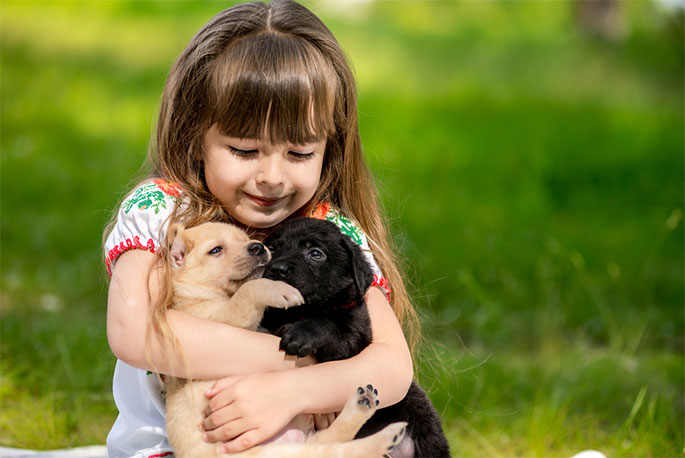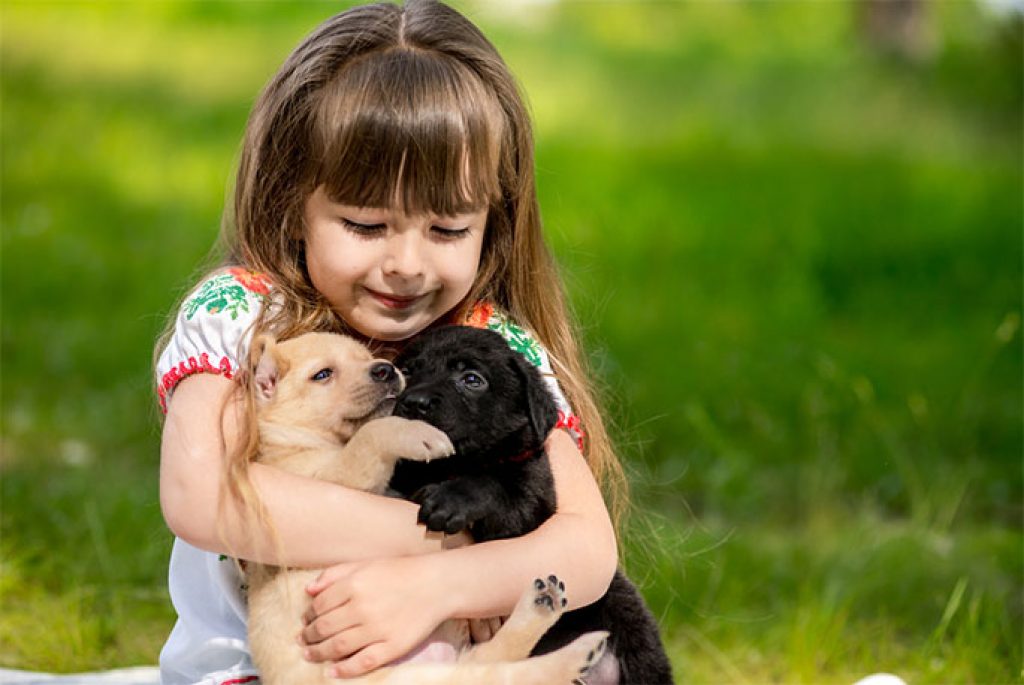
Kids and pets often enjoy the most remarkable relationships imaginable. Welcome a dog into your home from a rescue shelter and it quickly becomes a part of the family you cannot imagine living without.

Nevertheless, it’s important to remember that keeping things amicable (and even safe) where kids and pets are involved demands plenty of proactivity. Contrary to popular belief, you cannot simply throw kids and pets into the same household and expect domestic bliss to follow. It might, but it also might not – hence the need for a careful and considerate approach with plenty of common sense.
Read More:
- How to Train Your Dog to Play Nice With Children and Babies
- Tips for Adopting a Dog When You Have Small Children
- 8 Reasons Pets Keep Your Kids Healthy
- why pets are good for your health
- 10 Ways How Caring For Pets Teaches Children Responsibility
In this instance, let’s suggest you’re planning on bringing a new dog or puppy into your home. Let’s also assume this is to be your first pet, meaning your kids will have no experience living or interacting with animals. It’s an exciting prospect for everyone involved, but it’s also a scenario to approach with due care and caution.
Here are just a few tips from the experts on how to help kids and pets get along:
1. Educate Your Kids Ahead of Time
Surprising kids with a new dog or puppy can make for a seriously magical and memorable moment. Nevertheless, doing so provides you with no opportunity whatsoever to talk to your kids about what to expect ahead of time.
One of the best ways of ensuring your household is ready to welcome a new pet is to discuss the whole thing as a family in advance. Talk to your kids and explain to them how things will look with a dog around the place, where he’ll be sleeping, the new responsibilities he’ll bring to the household and so on.
Not to mention, the importance of giving him plenty of time and space to adjust during those sensitive early days.
2. Teach Your Kids How To Interact With Dogs
Under no circumstances should you simply assume that your kids will instinctively know how to interact safely and appropriately with a dog. Both for the comfort of the dog and the safety of your kids, there are several important rules they should be made aware of as follows:
- Never sneak up on a dog or take him by surprise, instead of approaching him slowly and ensuring he knows you are nearby.
- During the early days in particular, it is better to wait until the dog approaches you, rather than pushing yourself and your attention upon him.
- Where a dog appears frightened or nervous, give him time to come around and don’t be too forceful with your advances or petting.
- Never startle or disrupt a dog when it is sleeping or eating, as to do so could trigger an instinctive reaction on their part.
If it is safe and appropriate to pet the dog, do so slowly and gently under adult supervision at all times.
It can be useful to provide your kids with visual indicators (pictures or video clips) showing/reminding them how to approach and interact with a dog.
3. Clearly Communicate Responsibilities
Even before your new pet arrives home, everyone should be aware of their responsibilities where everyday care and cleaning are concerned. This ensures no nasty surprises further down the line, while at the same time helping maintain domestic bliss with a new member of the family.
Setting up a cleaning schedule or checklist can help, as can using the latest smart devices to lighten the load. If you’ve not already thought about picking one up, now could be the time to invest in a quality robot vacuum for pet hair to keep your floors clean and tidy. Not to mention, provide you with more free time to spend with your kids and your new pet.
4. Supervise All Interactions
Building fantastic relationships with pets is all about instilling good habits at the earliest possible stage. For obvious safety reasons, under no circumstances should children ever be left alone with dogs. Though it’s equally important to ensure all direct interactions are supervised carefully.
This will provide you with the opportunity to pick up on any potential problems or bad habits, which when corrected at an early stage are unlikely to resurface. For example, if your kids pet your dog too hard or on an area of his body he clearly doesn’t like, you can put a stop to it before it becomes problematic.
5. Be Aware of Body Language
Dogs can be surprisingly good at letting you know how they feel, without having to say (or bark) a word. Their posture, their demeanor, even the position of their tail can give you a good indication of whether they are happy, sad, angry, excited or simply want to be left alone.
These will be easier for you to pick up on in the early stages than your kids, but this doesn’t mean you can’t teach them about the basics of doggy body language. Arming your kids with the knowledge to determine when it is and isn’t appropriate to lavish a dog with attention can help avoid all sorts of issues.
6. Give Your Dog His Own Safe Space
Allocate a spot somewhere your new pet can retreat to when it all gets too much. It’s always good to provide a dog with a quiet and safe sanctuary of his own, which he’ll appreciate long-term. The key being to ensure that your kids know that when your dog retreats to his safe space, he shouldn’t be disturbed unless absolutely necessary.
Unless specifically instructed to do so, your kids should be told not to pet, pester or disturb your dog when he’s relaxing in his own space.
7. Lavish Your Kids with Praise and Attention
Last but not least, kids don’t always adjust as easily as you’d expect to a new pet around the place. They don’t know what’s right or wrong, they have a long list of rules to follow and they’ve new chores to take care of. They also have to deal with the fact that there’s a new cute and cuddly family member vying for the time and attention of their parents.
As a result, it’s essential to lavish your kids with praise and attention, ensuring they’re praised accordingly when they do the right thing. Expect mistakes and plan for a certain amount of jealousy, which is often an inevitable part of the adjustment process.
Popular Post:




